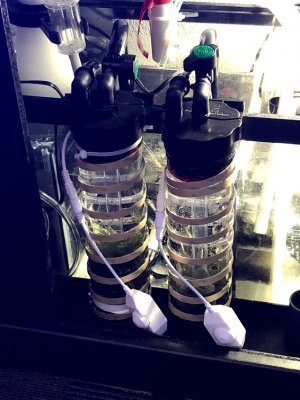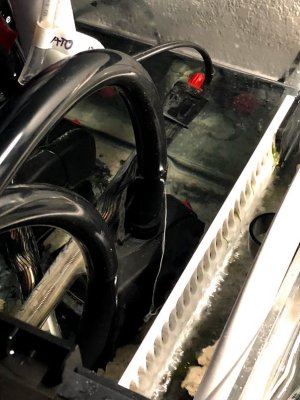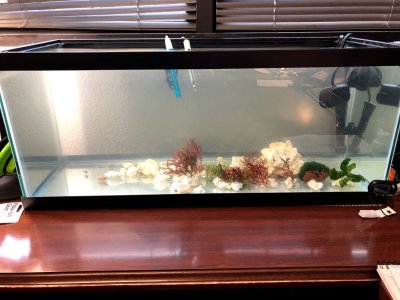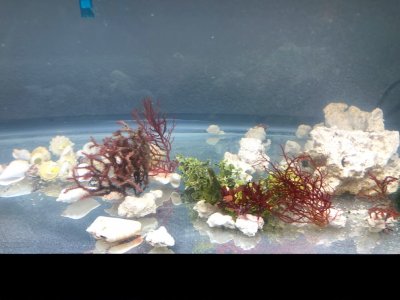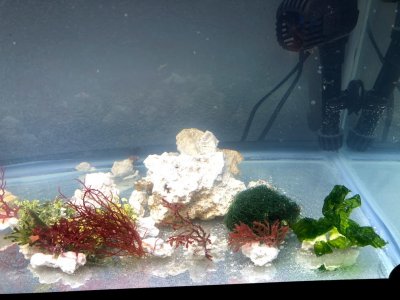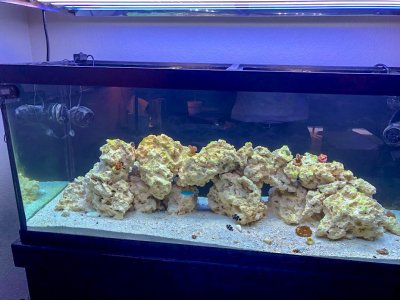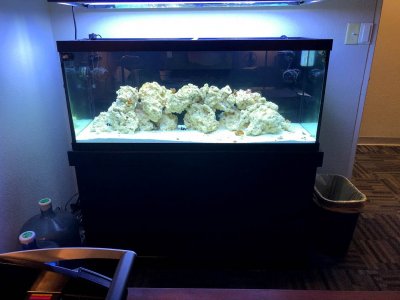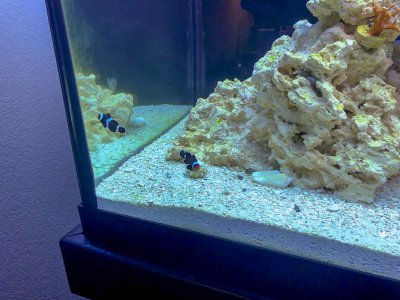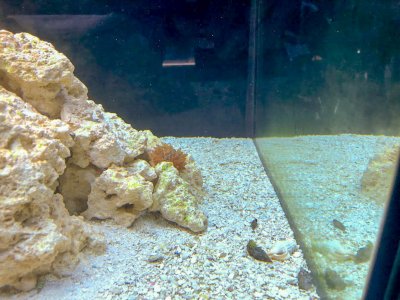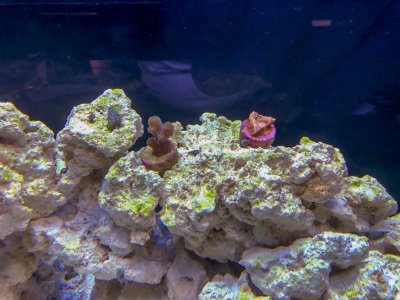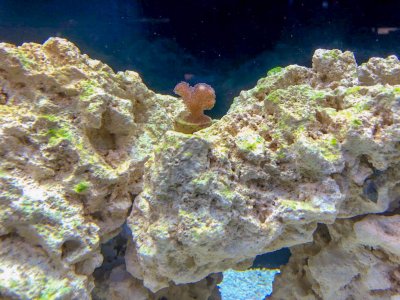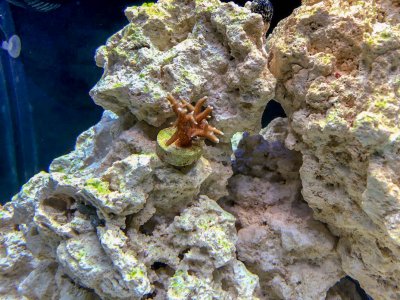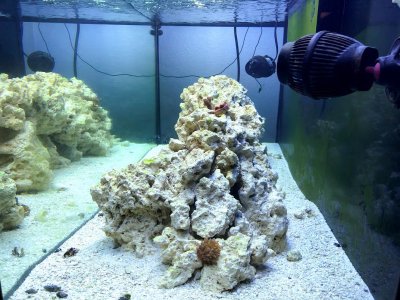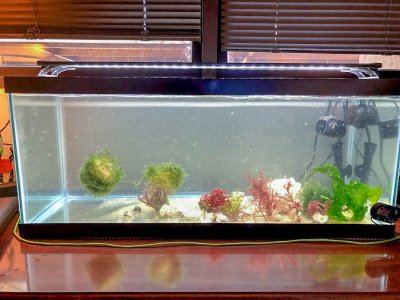So,
This is my first saltwater aquarium. It’s a 75 gallon Marineland PetSmart special. This size was picked due to space constraints and low sale price. It is my goal to have a thriving mixed reef community in my office. I am present in this office from precisely 7:45AM to 5PM Monday through Friday. This means that I will be depending on automation to keep things going.
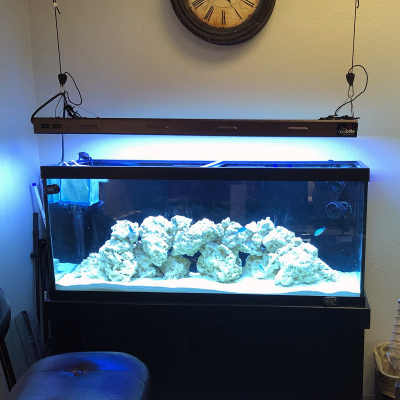
As you can see, I have the tank up and running. I’m using a cheap tank, cheap stand, cheap lights, cheap rock, a cheap sump, and cheap pumps. (Notice a theme? ) ... (The breeder net on the left is holding some chaeto I got the day the pic was taken... waiting on the reactor to get built... more on that in a few.)
) ... (The breeder net on the left is holding some chaeto I got the day the pic was taken... waiting on the reactor to get built... more on that in a few.)
It took about 3 weeks to get the sump built (…badly, I haven’t silicone sealed anything before…), holes drilled, overflow installed, and plumbing completed (also badly… never done that before, either.) I’m happy to go into more detail on any of those points if anyone asks any questions.
Then, it took about four more weeks to get the tank cycled using a large ammonia infusion. I just dumped a bunch in and let it ride. I have no idea how much I used. After I stopped reading ammonia (2 weeks), then stopped reading nitrite (another 3 days), and stabilized on nitrate readings (3 weeks), I dumped in some more ammonia and watched the show. I did a 60% water change, did it again, and did another 60% water change to get the nitrates down to about 20. I watched it for about 4 days and continued to see nitrates fall… which seems like magic - but I’ll take it. (No, I didn't have the Chaeto, yet.)
I am guessing the daily dosing of 4 capfuls of SeaChem Stability aided in the swift cycling and reduction of nitrates. How about that? They aren’t full of BS in their claims of the cocktail containing denitrifying bacteria… I wonder how they pulled that off.
The ultimate goal of this tank is to be a no-water-change system. Perhaps Triton or some similar method.
Anyway, here’s the plumbing and other tech stuff:
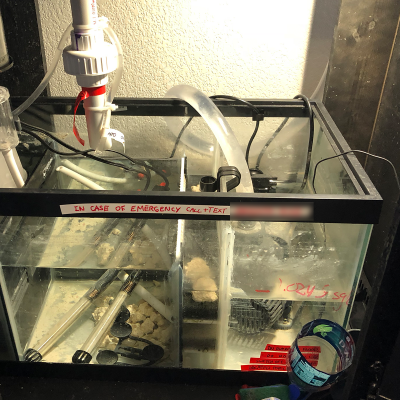
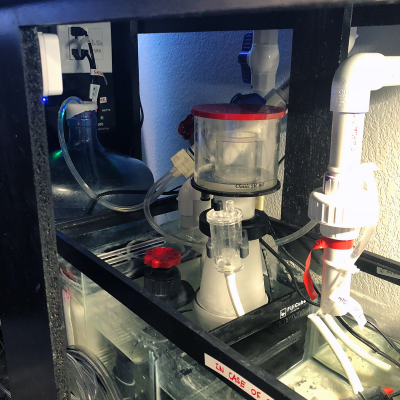
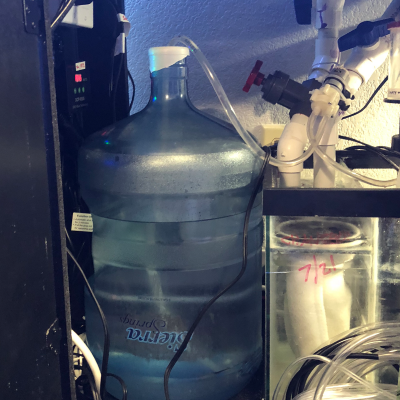
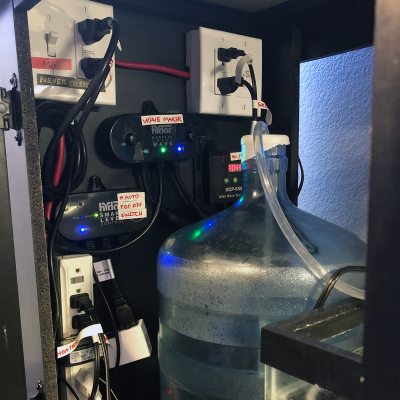
You are seeing a ($25) 20 gallon long tank (don’t be like me – go for the 40 breeder. 20 Gallon is barely big enough) with a ($99) fijicube.com baffle kit. The kit is superb, my silicone skills are not. The sump does a fine job, however. I’d just prefer it be a bit taller. Maybe a 29 would be sufficient.
The overflow is a ($160) Synergy Reef Shadow Overflow and the second most expensive component of the tank. I figured “go big” because it’s at work - and a flood would likely end my employment. I feel confident it will be fine. It’s plumbed up in a BeanAnimal setup that I am happy to show details on if anyone is interested in how I modified the included elbows to work this system as originally intended.
The Skimmer is a ($200) Reef Octopus 110INT Classic that will start doing something once there is a bioload. It’s fine. I dumped a couple ($20) 200-watt Marineland heaters in the sump until I have a more controllable solution (A lot more on this in a bit.) I am using a ($75) Jebao DCP-6500 return pump at 90% (probably could have gone a size up) that is doing quite well.
You may notice some DIY power strip thing in the sump. I have the main return, wave maker, ato, and skimmer plugged into this power strip. The on/off switch kills all four. Switching the power back on turns the main return pump and wave maker back on and starts a variable delay for the skimmer and the ATO. I have it currently set to five minutes. I can do a DIY thread on this, if anyone is interested.
I plan on growing Chaeto using one or two semi-DIY algae reactors from ($45) bio reactor kits from drsfostersmith and wrapping them with LED light strips from Amazon that teenagers use to grow weed. I bought two… so that should be plenty overkill to denitrify the tank – I’m guessing. Pics incoming once the reactors arrive.
There are four green chromis in the tank that are currently battling to the death – highlander style – and I have a 20g extra high kit coming in from reefcleaners.org along with half a dozen hermits. I think having 150 snails in a tank is ludicrous, so I went with a smaller package.
The rocks are just amazon cheap base rock. It’s working fine. I’m not super happy with the scape, but it’s my first whack and it seems to be generating good feedback from my coworkers. Open to feedback.
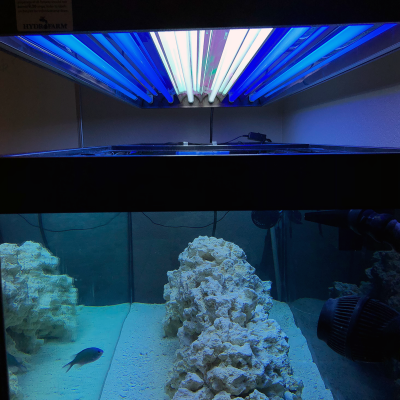
My lights are also something you might find in the converted closet of a dorm room growing pot. They are ($120) AgroBrite T5’s and a ($20) moonlight from Marineland. I pitched the included 6500k’s in the trash and installed 4x Actinic and 2x 10,000k by Hamilton Lighting from drsfostersmith ($10 each). They do well… It’s a very bright tank, now.
The next thing in the sump you might notice is my DIY auto top off. I found a pump on Amazon ($12) that I think was designed to distribute water for hydroponics basins (for more teens growing weed, I suppose) and I thought it might work. It does. I scavenged a 12v DC adapter and plugged it into a Hydor water level controller I got on clearance ($65). Worked a treat. Salinity is rock solid. I just tied a couple of air stones (as ballast) on a length of tubing and drop it into a 5-gallon jug of fresh that I change every four days (Tuesday morning and Friday afternoon.)
You may note that I have tags on everything. This is in the case of an emergency and I’m not around. I want to be able to tell the secretary how to solve a problem over the telephone. Labels are critical to not making a bad day worse.
That leads me to automation... this is gonna take a minute to share my vision…
I initially thought the Apex system to be insultingly expensive. Turns out, it isn’t. It’s a fair deal. But, to find this out, I began a thought experiment to see how much it would take for me to design my own. I’m guessing it will take about $500 to build my own controller from scratch. It will require a tremendous amount of experimentation and design that I have never attempted before. So, $800 plus add-ons for a commercial ready product seems quite fair.
Alas, I’ve already done the work in my head and now I want to know if I have what it takes to make it real. So, I’m going to make my own out of a Raspberry Pi and a bunch of relays and other components instead of buy one. I’ve never really soldered electronics before… and never programmed anything, either. So, this should be interesting. I’ve read what others have attempted and I think I can get this done on my own – value proposition be danged. It’s time to stretch my Google-Fu skills and make it happen.
Here’s my goal: I want a Raspberry Pi controlling all equipment and taking full sensor measurements 24/7 - and logging/serving them to a web-accessible database with a web interface. An Android app would be pretty slick, too. I’d like to have a wireless touchscreen tablet control on the wall. So – I better add UI design to the list of things I don’t know how to do, either.
I think I’ll need 26 relay-controlled outlets (So I’ll do a few extra - 4x boxes for a total of 32 channels of remote controlled outlets); all accessible for manual/timer/intelligent IFTT-style control via app. Turns out, the hardware is a pretty trivial matter as it is a standard integrated circuit connected via a digital bus to the Pi using two wires. Cool. These controlled relays will run lights, pumps, reactors, skimmer – everything connected to power.
Next, I want a few temperature probes, a few PH probes, an ORP (I guess… I don’t fully understand the science on this one, yet), a salinity probe, and space for a few more probes like dissolved oxygen and a second salinity probe. I then want optical level sensors for ATO (low/High/Emergency/Reservoir) and another one for each of the dosing containers that I will eventually have. The Neptune DOS &DDR sell for $225 per chamber. That’s insulting. I think I can do it for about $19 per chamber including the peristaltic pumps and optical sensors. So, I’ll start with 4 chambers and keep room for another 4 if I ever need to expand my dosing regime. I also think I’d rather find a way to mount the pump directly on the reservoir lid… maybe on the side (?)… I’ll keep stewing on that one…
I also want to eventually get an alkalinity controller. Those are so cool. What an amazing addition to the hobby. You Old Salts must be beside yourselves in excitement for such an innovation. I don’t know how I could easily replicate one on my own because I have no clue how they work. I’ll research that, but in the meantime, I am planning on getting a Kh Guardian about a year from now. So, I’ll plan my controls to interface with that device in an intelligent manner, somehow, too. (If that’s even possible.)
I also want to access and control a couple of webcams for sump, tank, and room.
Finally, I also want a flow sensor on the return pump and ATO pump because parameter co-witnessing means I can be on a weeks-long business trips and not panic that my reef is dying. I’m also curious how much water is being moved. I think more data is better. So, why not? The sensors are only a couple of bucks and I’m planning to have 32 channels of i2c input/output available to utilize.
You may be wondering why the redundancy on a few of these sensors. I plan on having a full-time macro algae tank on my desk (because algae are cool) that will be optionally transitioned into a hospital/refuge tank as needed going on my desktop. It’ll be a separate system. Having a probe rack tucked in the back of a small biocube (and full control of all electrical components) would just be nerdy and fun. I think I can do it – therefore I will.
So, in summary, I need to learn how to do the following: hook up a Pi to these various components and make them interface, program them all to interact in whatever language that will be, set up a web server, figure out how to log all this data, serve all this real time data to end users in a visually pleasing manner, reliably control/time/program all those relays and sensors, and design a user interface that is intuitive.
It’s quite a project considering I bring to the table no actual experience in any of these fields. But, I was bored - and I started this tank to get a challenge. I think this will do just fine.
I guess I should start a DIY thread once I get a few things off paper and in the real word. Parts are ordered, so it should be soon. I’ll update this thread once I do.
Thoughts on the tank or the vision?

This is my first saltwater aquarium. It’s a 75 gallon Marineland PetSmart special. This size was picked due to space constraints and low sale price. It is my goal to have a thriving mixed reef community in my office. I am present in this office from precisely 7:45AM to 5PM Monday through Friday. This means that I will be depending on automation to keep things going.

As you can see, I have the tank up and running. I’m using a cheap tank, cheap stand, cheap lights, cheap rock, a cheap sump, and cheap pumps. (Notice a theme?
It took about 3 weeks to get the sump built (…badly, I haven’t silicone sealed anything before…), holes drilled, overflow installed, and plumbing completed (also badly… never done that before, either.) I’m happy to go into more detail on any of those points if anyone asks any questions.
Then, it took about four more weeks to get the tank cycled using a large ammonia infusion. I just dumped a bunch in and let it ride. I have no idea how much I used. After I stopped reading ammonia (2 weeks), then stopped reading nitrite (another 3 days), and stabilized on nitrate readings (3 weeks), I dumped in some more ammonia and watched the show. I did a 60% water change, did it again, and did another 60% water change to get the nitrates down to about 20. I watched it for about 4 days and continued to see nitrates fall… which seems like magic - but I’ll take it. (No, I didn't have the Chaeto, yet.)
I am guessing the daily dosing of 4 capfuls of SeaChem Stability aided in the swift cycling and reduction of nitrates. How about that? They aren’t full of BS in their claims of the cocktail containing denitrifying bacteria… I wonder how they pulled that off.
The ultimate goal of this tank is to be a no-water-change system. Perhaps Triton or some similar method.
Anyway, here’s the plumbing and other tech stuff:




You are seeing a ($25) 20 gallon long tank (don’t be like me – go for the 40 breeder. 20 Gallon is barely big enough) with a ($99) fijicube.com baffle kit. The kit is superb, my silicone skills are not. The sump does a fine job, however. I’d just prefer it be a bit taller. Maybe a 29 would be sufficient.
The overflow is a ($160) Synergy Reef Shadow Overflow and the second most expensive component of the tank. I figured “go big” because it’s at work - and a flood would likely end my employment. I feel confident it will be fine. It’s plumbed up in a BeanAnimal setup that I am happy to show details on if anyone is interested in how I modified the included elbows to work this system as originally intended.
The Skimmer is a ($200) Reef Octopus 110INT Classic that will start doing something once there is a bioload. It’s fine. I dumped a couple ($20) 200-watt Marineland heaters in the sump until I have a more controllable solution (A lot more on this in a bit.) I am using a ($75) Jebao DCP-6500 return pump at 90% (probably could have gone a size up) that is doing quite well.
You may notice some DIY power strip thing in the sump. I have the main return, wave maker, ato, and skimmer plugged into this power strip. The on/off switch kills all four. Switching the power back on turns the main return pump and wave maker back on and starts a variable delay for the skimmer and the ATO. I have it currently set to five minutes. I can do a DIY thread on this, if anyone is interested.
I plan on growing Chaeto using one or two semi-DIY algae reactors from ($45) bio reactor kits from drsfostersmith and wrapping them with LED light strips from Amazon that teenagers use to grow weed. I bought two… so that should be plenty overkill to denitrify the tank – I’m guessing. Pics incoming once the reactors arrive.
There are four green chromis in the tank that are currently battling to the death – highlander style – and I have a 20g extra high kit coming in from reefcleaners.org along with half a dozen hermits. I think having 150 snails in a tank is ludicrous, so I went with a smaller package.
The rocks are just amazon cheap base rock. It’s working fine. I’m not super happy with the scape, but it’s my first whack and it seems to be generating good feedback from my coworkers. Open to feedback.

My lights are also something you might find in the converted closet of a dorm room growing pot. They are ($120) AgroBrite T5’s and a ($20) moonlight from Marineland. I pitched the included 6500k’s in the trash and installed 4x Actinic and 2x 10,000k by Hamilton Lighting from drsfostersmith ($10 each). They do well… It’s a very bright tank, now.
The next thing in the sump you might notice is my DIY auto top off. I found a pump on Amazon ($12) that I think was designed to distribute water for hydroponics basins (for more teens growing weed, I suppose) and I thought it might work. It does. I scavenged a 12v DC adapter and plugged it into a Hydor water level controller I got on clearance ($65). Worked a treat. Salinity is rock solid. I just tied a couple of air stones (as ballast) on a length of tubing and drop it into a 5-gallon jug of fresh that I change every four days (Tuesday morning and Friday afternoon.)
You may note that I have tags on everything. This is in the case of an emergency and I’m not around. I want to be able to tell the secretary how to solve a problem over the telephone. Labels are critical to not making a bad day worse.
That leads me to automation... this is gonna take a minute to share my vision…
I initially thought the Apex system to be insultingly expensive. Turns out, it isn’t. It’s a fair deal. But, to find this out, I began a thought experiment to see how much it would take for me to design my own. I’m guessing it will take about $500 to build my own controller from scratch. It will require a tremendous amount of experimentation and design that I have never attempted before. So, $800 plus add-ons for a commercial ready product seems quite fair.
Alas, I’ve already done the work in my head and now I want to know if I have what it takes to make it real. So, I’m going to make my own out of a Raspberry Pi and a bunch of relays and other components instead of buy one. I’ve never really soldered electronics before… and never programmed anything, either. So, this should be interesting. I’ve read what others have attempted and I think I can get this done on my own – value proposition be danged. It’s time to stretch my Google-Fu skills and make it happen.
Here’s my goal: I want a Raspberry Pi controlling all equipment and taking full sensor measurements 24/7 - and logging/serving them to a web-accessible database with a web interface. An Android app would be pretty slick, too. I’d like to have a wireless touchscreen tablet control on the wall. So – I better add UI design to the list of things I don’t know how to do, either.
I think I’ll need 26 relay-controlled outlets (So I’ll do a few extra - 4x boxes for a total of 32 channels of remote controlled outlets); all accessible for manual/timer/intelligent IFTT-style control via app. Turns out, the hardware is a pretty trivial matter as it is a standard integrated circuit connected via a digital bus to the Pi using two wires. Cool. These controlled relays will run lights, pumps, reactors, skimmer – everything connected to power.
Next, I want a few temperature probes, a few PH probes, an ORP (I guess… I don’t fully understand the science on this one, yet), a salinity probe, and space for a few more probes like dissolved oxygen and a second salinity probe. I then want optical level sensors for ATO (low/High/Emergency/Reservoir) and another one for each of the dosing containers that I will eventually have. The Neptune DOS &DDR sell for $225 per chamber. That’s insulting. I think I can do it for about $19 per chamber including the peristaltic pumps and optical sensors. So, I’ll start with 4 chambers and keep room for another 4 if I ever need to expand my dosing regime. I also think I’d rather find a way to mount the pump directly on the reservoir lid… maybe on the side (?)… I’ll keep stewing on that one…
I also want to eventually get an alkalinity controller. Those are so cool. What an amazing addition to the hobby. You Old Salts must be beside yourselves in excitement for such an innovation. I don’t know how I could easily replicate one on my own because I have no clue how they work. I’ll research that, but in the meantime, I am planning on getting a Kh Guardian about a year from now. So, I’ll plan my controls to interface with that device in an intelligent manner, somehow, too. (If that’s even possible.)
I also want to access and control a couple of webcams for sump, tank, and room.
Finally, I also want a flow sensor on the return pump and ATO pump because parameter co-witnessing means I can be on a weeks-long business trips and not panic that my reef is dying. I’m also curious how much water is being moved. I think more data is better. So, why not? The sensors are only a couple of bucks and I’m planning to have 32 channels of i2c input/output available to utilize.
You may be wondering why the redundancy on a few of these sensors. I plan on having a full-time macro algae tank on my desk (because algae are cool) that will be optionally transitioned into a hospital/refuge tank as needed going on my desktop. It’ll be a separate system. Having a probe rack tucked in the back of a small biocube (and full control of all electrical components) would just be nerdy and fun. I think I can do it – therefore I will.
So, in summary, I need to learn how to do the following: hook up a Pi to these various components and make them interface, program them all to interact in whatever language that will be, set up a web server, figure out how to log all this data, serve all this real time data to end users in a visually pleasing manner, reliably control/time/program all those relays and sensors, and design a user interface that is intuitive.
It’s quite a project considering I bring to the table no actual experience in any of these fields. But, I was bored - and I started this tank to get a challenge. I think this will do just fine.
I guess I should start a DIY thread once I get a few things off paper and in the real word. Parts are ordered, so it should be soon. I’ll update this thread once I do.
Thoughts on the tank or the vision?
Last edited:






